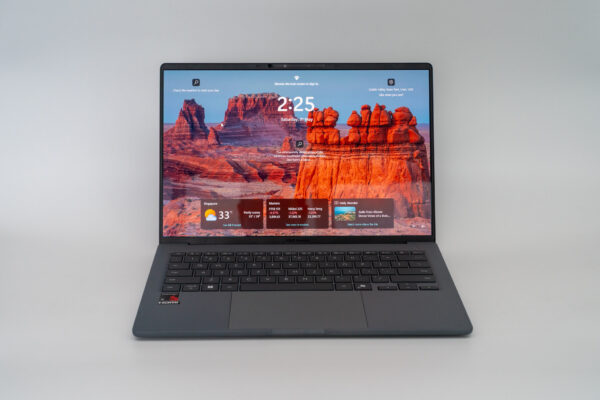
Want an ultralight laptop with forever battery-life that runs Windows? Look no further. ASUS’ Zenbook A14 may be exactly what you want. That it is powered by a Qualcomm Snapdragon CPU shouldn’t, I hope, be a problem for you.
I admit that I’m a little disappointed that laptops powered by Qualcomm Snapdragon X processors running Windows on Arm haven’t been more popular. The long battery life is a godsend for anyone who has to work on a laptop on-to-go, as it takes away anxiety about battery power.
The Zenbook A14 comes after other ASUS’ Snapdragon powered laptop like the Vivobook S 15. Vivobook 14, Vivobook 16, and ProArt PZ13. This is the first Zenbook with a Snapdragon processor, and it brings with it Zenbook-signature features such as the Ceraluminum material used to build the laptop.
Ceraluminum is a ceramic-coated aluminum material that combines the lightweight durability with exceptional strength. The anti-wear, anti-scratch, and smudge-free material is easy to maintain, and always looks great. The Zenbook A14’s chassis looks unique, always looks pristine, and it’s amazingly lightweight.
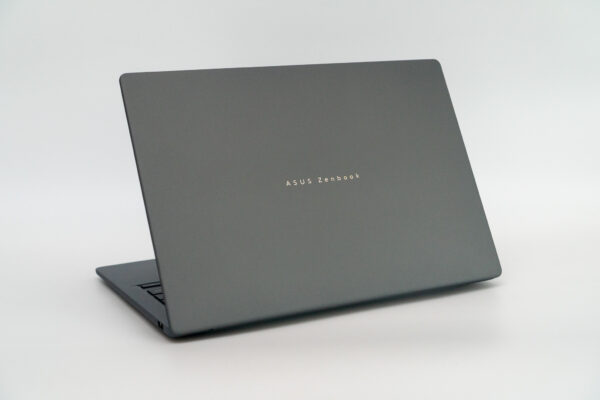
How light? 0.98 kg. That’s right, the Zenbook A14 with a 14-inch display doesn’t even weight a whole kilogram. As I took my review unit through its paces, I am constantly reminded how heavy my other laptops are. If I didn’t turn it on, I might even think it was a dummy set.
The overall dimensions of the Zenbook A14, at 310.7 x 213.9 x 13.4 ~ 15.9 mm (WxDxH) are about as compact as you can get a 14-inch display laptop to be. Overall, the size, weight, and durable build of the Zenbook A14 makes it a great laptop to bring with you on all your journeys and adventures, no TLC required. (But of course, treat your laptop well.)
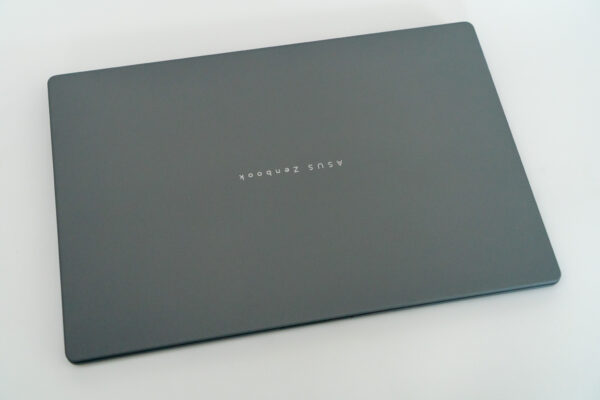
The Zenbook A14 has a 14-inch WUXGA 1920 x 1200 resolution OLED panel. In 2025, with a 14-inch screen, I would have expected 2304 x 1536 at the least, if not 2560 x 1600, so this is perhaps slightly underwhelming. I’m not convinced the beautiful OLED display with 400 nits, with HDR peaking at 600 nits, makes up for it. If you are just a casual user, the Zenbook A14’s resolution is perhaps just fine. The Zenbook A14, after all, is not designed to be a workhorse. People like me who want to squeeze the most out of the screen real estate may feel there’s not enough pixels for comfort.
The display, however, is otherwise really good. I can’t verify this independently as my colourimeter doesn’t work on ARM, but ASUS’ specs states 100% DCI-P3 colour gamut. The display has 0.2 ms response time and 60 Hz refresh rate.
The next feature, or the lack thereof, may not be a big deal for most people. However, it’s now 2025, to have a laptop that still uses a non-touch display is at least a bit disappointing to me. IA touch-enabled display isn’t at all uncommon in Windows laptops. I know this won’t be a showstopper for many people, but it would be a really nice bonus to have.
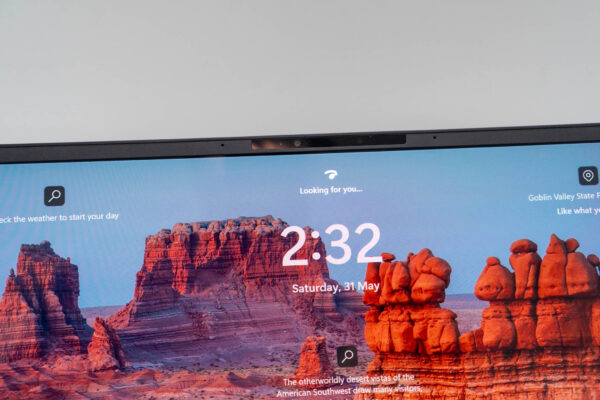
The webcam sitting atop the Zenbook A14 is a typical Full-HD camera with IR function to support Windows Hello. Facial recognition login works seamlessly as I’d expect, and the camera quality is fine. There is no physical privacy shutter, in case that’s something you look out for. The microphone works well, not great, but suffices for online meetings.
The Zenbook A14 has a chiclet-style keyboard. The keys are backlit, and there’s a decent 1.3 mm of key travel. Typing is generally comfortable.
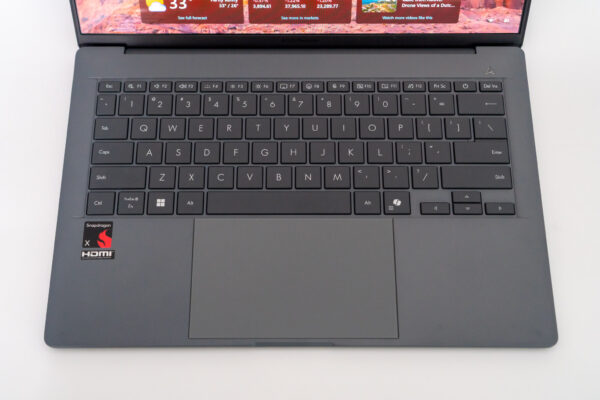
The trackpad is a good size, though not particularly expansive. It’s a mechanical one which clicks physically. I know some people would much prefer a haptic-touch trackpad. Personally, this doesn’t really bother me that much because I usually tap-to-click anyway.
ASUS has tried many things to add tricks to the trackpad on their laptops. The numberpad mode has been one of their long-time features. The newer smart gestures available on this laptop allow you to slide on the trackpad edges to control volume and display brightness.
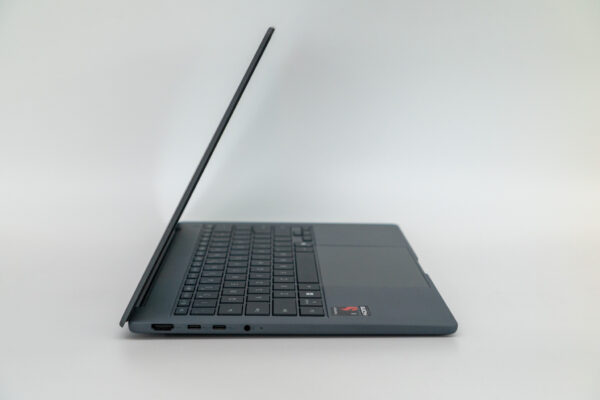
The Zenbook A14 has a decent offering of physical ports. They are mostly on the left side, starting with a HDMI 2.1 port, two USB 4.0 TGen 3 Type-C ports, and a combo audio jack. The USB Type-C ports support power delivery and display.
The right side has a lone USB 3.2 Gen 2 Type-A port. I would really prefer to have one of the Type-C ports on this side, so that at least you have a choice to plug in the Type-C cable to either side of the laptop.
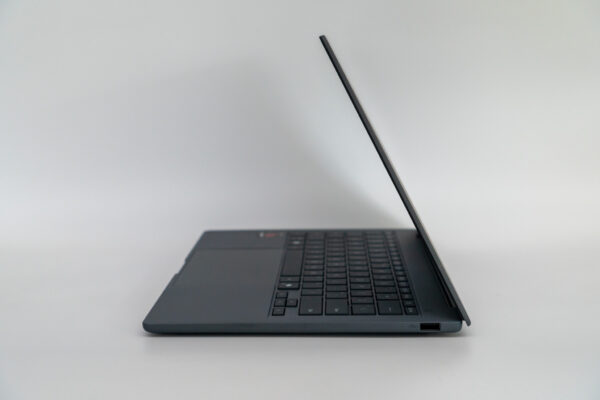
The Zenbook A14 is available in several Snapdragon processor options. The one I have is the Snapdragon X X1-26-100 processor. This is the most budget-friendly processor variant, launched after the original X Elite and X Plus processors. It has 8 cores, 8 threads, clocked at 3.0 GHz. There is less cache, andt he iGPU has substantially less TFLOPS. The NPU has the same 45 TOPS as all the other Snapdragon X processors.
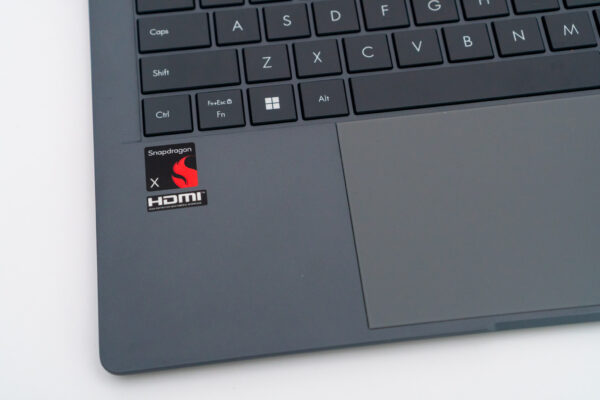
My review unit was also configured with 16 GB of LPDDR5x RAM and 1 TB of NVMe storage.
The lower-tier Snapdragon X processor does show in synthetic benchmarks. Geekbench 6 scores, for example, for my Zenbook A14 are 2112, 10480, and 9395 for single-core-, multi-core, and compute respectively. This is in balanced battery mode. The Microsoft Surface 7 with the X Plus processor scored 2305, 12502, and 19215. CPU performance itself is not significantly worse, but the iGPU is a different story altogether.
In Cinebench R24, the Zenbook A14 scored 91 and 294 for single-core and mutl-core respectively. The Microsoft Surface 7 clocked in at 105 and 697.
Nevertheless, I found that in actual use, the Zenbook A14’s Snapgradon X processor did fine. I did not have any issues with casual web browsing and office productivity work. At no time did I feel like the laptop was lagging or underperforming.

The most amazing thing about the Zenbook A14 is its battery life. The huge 70 Wh capacity Li-ion battery, combined with the Snapdragon’s power efficiency, allowed me to stream 4K video on YouTube over Wi-Fi for 20 hours 11 minutes. ASUS claims 32 hours of video playback. While I didn’t get even two-thirds of that, it is the best I’ve ever tested among any Windows laptop, and I think this comfortably qualifies as a multi-day battery for casual users.
The Zenbook A14 is overall an impressive laptop. It’s ultralight, durably built, adequate for casual uses, and an amazing battery life. I did wish it had a higher resolution display as well as a touch-enabled display.
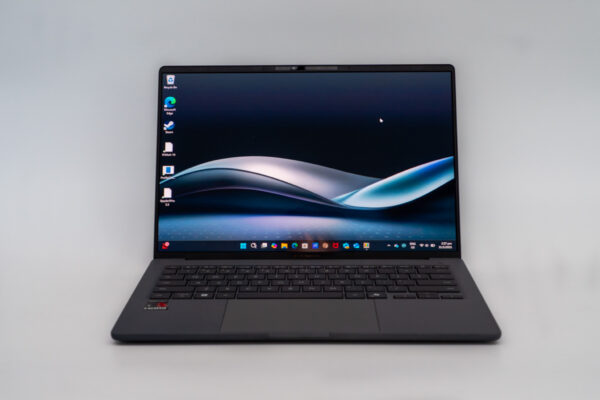
If you’re looking for an ultralight Windows laptop with insane battery life for casual use, the Zenbook A14 is a great recommendation. Just, of course, as long as an ARM-based processor works for you. This is likely the case for casual users whose main use is web browsing and office productivity work.
The retail price of the Zenbook A14 as configured in this review (Snapdragon X X1-2-100, 16 GB RAM, 1 TB storage) is $1,699.
View Comment Policy